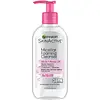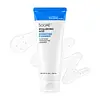What's inside
What's inside
 Key Ingredients
Key Ingredients

 Benefits
Benefits

 Concerns
Concerns

No concerns
 Ingredients Side-by-side
Ingredients Side-by-side

Water
Skin ConditioningGlycerin
HumectantPEG-200 Hydrogenated Glyceryl Palmate
CleansingCoco-Betaine
CleansingSodium Laureth Sulfate
CleansingPolysorbate 20
EmulsifyingPEG-7 Glyceryl Cocoate
EmulsifyingCitric Acid
BufferingCocamide Mea
EmulsifyingPEG-55 Propylene Glycol Oleate
Polyquaternium-11
PPG-5-Ceteth-20
EmulsifyingPropylene Glycol
HumectantSodium Benzoate
MaskingSodium Chloride
MaskingSodium Hydroxide
BufferingVitis Vinifera
MaskingCeramide AP
Skin ConditioningWater, Glycerin, PEG-200 Hydrogenated Glyceryl Palmate, Coco-Betaine, Sodium Laureth Sulfate, Polysorbate 20, PEG-7 Glyceryl Cocoate, Citric Acid, Cocamide Mea, PEG-55 Propylene Glycol Oleate, Polyquaternium-11, PPG-5-Ceteth-20, Propylene Glycol, Sodium Benzoate, Sodium Chloride, Sodium Hydroxide, Vitis Vinifera, Ceramide AP
Water
Skin ConditioningGlycerin
HumectantSodium Cocoyl Alaninate
Hydroxypropyl Methylcellulose
Emulsion Stabilising1,2-Hexanediol
Skin ConditioningSodium Hyaluronate
HumectantHydroxypropyltrimonium Hyaluronate
Hydrolyzed Hyaluronic Acid
HumectantSodium Acetylated Hyaluronate
HumectantHyaluronic Acid
HumectantHydrolyzed Sodium Hyaluronate
Skin ConditioningSodium Hyaluronate Crosspolymer
HumectantPotassium Hyaluronate
Skin ConditioningChamaecyparis Obtusa Water
MaskingChamomilla Recutita Flower Water
MaskingCitric Acid
BufferingHydroxyethylcellulose
Emulsion StabilisingDisodium EDTA
Ethylhexylglycerin
Skin ConditioningButylene Glycol
HumectantWater, Glycerin, Sodium Cocoyl Alaninate, Hydroxypropyl Methylcellulose, 1,2-Hexanediol, Sodium Hyaluronate, Hydroxypropyltrimonium Hyaluronate, Hydrolyzed Hyaluronic Acid, Sodium Acetylated Hyaluronate, Hyaluronic Acid, Hydrolyzed Sodium Hyaluronate, Sodium Hyaluronate Crosspolymer, Potassium Hyaluronate, Chamaecyparis Obtusa Water, Chamomilla Recutita Flower Water, Citric Acid, Hydroxyethylcellulose, Disodium EDTA, Ethylhexylglycerin, Butylene Glycol
 Reviews
Reviews

Ingredients Explained
These ingredients are found in both products.
Ingredients higher up in an ingredient list are typically present in a larger amount.
Citric Acid is an alpha hydroxy acid (AHA) naturally found in citrus fruits like oranges, lemons, and limes.
Like other AHAs, citric acid can exfoliate skin by breaking down the bonds that hold dead skin cells together. This helps reveal smoother and brighter skin underneath.
However, this exfoliating effect only happens at high concentrations (20%) which can be hard to find in cosmetic products.
Due to this, citric acid is usually included in small amounts as a pH adjuster. This helps keep products slightly more acidic and compatible with skin's natural pH.
In skincare formulas, citric acid can:
While it can provide some skin benefits, research shows lactic acid and glycolic acid are generally more effective and less irritating exfoliants.
Most citric acid used in skincare today is made by fermenting sugars (usually from molasses). This synthetic version is identical to the natural citrus form but easier to stabilize and use in formulations.
Read more about some other popular AHA's here:
Learn more about Citric AcidGlycerin is already naturally found in your skin. It helps moisturize and protect your skin.
A study from 2016 found glycerin to be more effective as a humectant than AHAs and hyaluronic acid.
As a humectant, it helps the skin stay hydrated by pulling moisture to your skin. The low molecular weight of glycerin allows it to pull moisture into the deeper layers of your skin.
Hydrated skin improves your skin barrier; Your skin barrier helps protect against irritants and bacteria.
Glycerin has also been found to have antimicrobial and antiviral properties. Due to these properties, glycerin is often used in wound and burn treatments.
In cosmetics, glycerin is usually derived from plants such as soybean or palm. However, it can also be sourced from animals, such as tallow or animal fat.
This ingredient is organic, colorless, odorless, and non-toxic.
Glycerin is the name for this ingredient in American English. British English uses Glycerol/Glycerine.
Learn more about GlycerinWater. It's the most common cosmetic ingredient of all. You'll usually see it at the top of ingredient lists, meaning that it makes up the largest part of the product.
So why is it so popular? Water most often acts as a solvent - this means that it helps dissolve other ingredients into the formulation.
You'll also recognize water as that liquid we all need to stay alive. If you see this, drink a glass of water. Stay hydrated!
Learn more about Water